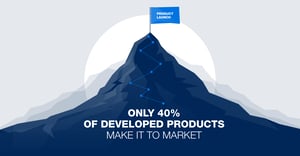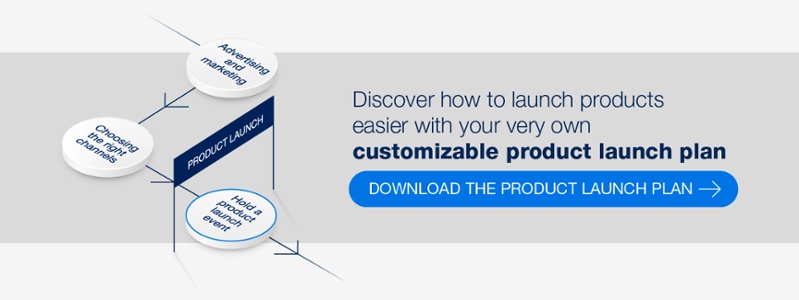It’s pretty safe to say that there isn’t one single business that launches a new product with the intention of seeing it fail. But the reality is that products that become a smash hit, breaking all the sales records, are a rarity. In fact, the majority of product launches fail to meet sales expectations, or, even worse, are completely rejected by the market.
As an established company with many products in the market, you might have already experienced a failed product launch or two. You might still be waiting to launch that one product that the consumer goes crazy for. Wouldn’t you like to know what you can do to minimize the risk of a failed product launch and ensure success?
The first thing is to learn from your mistakes. What did you do (or didn't do) that contributed to the failure of previous product launches? Unfortunately, answering this question isn't always as simple as you might think. There is a multitude of factors that come into play when planning your go-to-market strategy for a product launch, and not all of them are easily predicted.
5 areas where most product launches fail
- Timing
- Advertising and marketing
- Consumers and their needs
- The market
- Pricing
What are the causes of failure in the product launching?
Any one single factor, or a combination of several, could be the reason a product is a failure rather than a success. It could be priced too high for your target market. Or, maybe the consumer simply doesn’t need the product.
Perhaps the timing of the product launch was off. Maybe the timing was right, but you targeted the wrong market. Maybe a competitor released a product that offered the consumer more features or benefits. Maybe they positioned it better than you did.
The checklist could go on even more, but you get a general idea. Sometimes it’s just really difficult to determine why most product launches fail. However, the failure can often be attributed to one of the following 5 factors. Consider the following reasons why most product launches fail and the next time you plan a go-to-market strategy for a new product, you may be better equipped with the knowledge you need to ensure that the product launch is a success.
Timing
When they say timing is everything, you’d do well to listen. Timing is a critical factor that comes into play in all aspects of a product launch. Rush a product launch without doing adequate preparation, and it will fail. Take too long and miss out on a marketing opportunity, and it will fail.
So when is the perfect time for a product launch? Generally, as soon as the product is ready. But that means you should have spent several months prior to planning your marketing, advertising, collecting consumer data through research, surveys and analytics, and conducting testing.
Create a product launch roadmap that defines your goals, lays out the plan for your strategy, and assigns tasks to the various teams and individuals in your organization that will take part in implementing the launch. Consider the following components that are integral to getting the timing right.
Customer preference
Launching your product when the market most desires the features and benefits it provides will serve to maximize sales. Ask yourself if there is a particular time of year that the product will be more well-received. Avoid releasing your product before a major holiday, as consumers are more focused on other things at those times.
Quality
Don’t rush the product or quality could suffer. Consider a small, test rollout to gauge feedback and make any necessary adjustments.
Competitors
Are your competitors also moving forward with product launches? You may want to try to beat your competitor to grab a larger share of sales, but sometimes waiting until after a competitor launch could be more prudent. The market will become familiar with a product’s features, and then you could release your product when demand grows.
Marketing
Align the launch with your marketing by building your go-to-market strategy around the proposed launch date. To avoid having to wait for your marketing assets for the launch, consider making your "photoshoot" in 3D. This way, you decrease your lead time on marketing assets and you'll be ready to launch as soon as the product is developed.
Learn how Vauni used our Location Library to reduce time to market on their marketing assets

Advertising and marketing
A lack of proper marketing and advertising is another major reason why most product launches fail. Development of a go-to-market plan that leads up to your launch can significantly increase your chances of generating positive attention around the product before its release, serving to increase sales thereafter.
Depending on your audience, you can utilize some or all of these pre-launch strategies to help you accomplish a successful product launch.
- Content marketing to drive traffic to your website.
- Social media marketing.
- Collaborate with key influencers in the industry.
- Email marketing.
- Webinars
- A product launch event
When determining what channels to use and how to prepare your marketing and advertising, you must first be aware of three things:
- The pain points of your customers.
- What your competitors are doing.
- What type of advertising messaging would best resonate with your audience.
Before launching your product, you need to identify consumer needs and determine if there is even a need for your product in the market right now. You can conduct research and gather survey data, while also attempting to gauge how much the consumer will be willing to pay for the product. Pricing is another reason why most product launches fail and will be discussed shortly.
You might also like: "6 things you need to consider when advertising your new product launch"
Today’s marketplace is also quite competitive, and there could be several products similar to yours already released or soon to be released by competitors. Study their marketing and advertising, try to determine what is working and what isn’t. Examine the keywords they used in their own content marketing. See how well they perform and engage with their audience on social media channels.

Then, create your own Unique Selling Proposition (USP) based on customer needs, the competitor's product offerings, the benefits delivered by your own product, and the value of your brand promise. Highlighting these four criteria and making them a regular mantra of all your marketing and advertising will set you apart from the competition and improve your chances of success.
To truly ramp up your marketing and advertising efforts, use Location Library to provide consumers with high-quality 3D visualizations of your products in unique settings. Using Location Library also serves to reduce lead time and it enables you to go to market even before your product is manufactured, giving you a jump on competitors.
Learn more about clients who got high-quality visuals quickly and at a fraction of the cost with Location Library Partner Solution.
Read more about Fritz Hansen and their story with 3D visualization.

Consumers and their needs
You may have already realized that understanding consumer needs is also vitally important to the success of a product launch. And, although there have been many major advances in the methods utilized to understand consumer behavior, many businesses still fail to fully account for this highly crucial component.
Put simply, a new product that doesn’t fulfill consumer needs or wants will fail.
If possible, conduct trials on a small scale and garner customer feedback. Sometimes it’s simply a matter of adjusting one small detail that can make a huge difference in a product’s success or its failure. Product managers should do their best not to let their ego get in the way of making the proper decision and ignoring the advice of the test market or third-party review.
Additionally, it may be best to avoid releasing a product into a market that is already over-saturated with similar products if yours doesn’t offer at least one benefit or feature that the competitors don’t. Otherwise, consumer demand will likely be rather low.
To truly understand your customers, the ideal tool is right before you — social media. By engaging with your customers on a consistent basis, you can really learn a lot about how they feel about your brand and your products. There are also a number of useful tools you can use for further engagement, such as messaging tools for customer service or chatting with a customer as they explore your website.
You should also have created a buyer persona. And aside from using the basic demographics such as age and location, dig deeper by using Google Analytics to see where your website traffic comes from. This can help you gain greater insight into the minds of your customers and subsequently develop products and advertising that resonate more effectively.
Consider the customer journey. What touchpoints does the customer come across when researching your brand. Put yourself in the customer’s shoes and see where your own journey might lead you. This will better help you to identify failed touchpoints and make the necessary adjustments to better speak to and guide the consumer along the right path to a sales conversion.

The market
Believe it or not, many products fail simply because companies focused on the wrong market. If a particular audience has no need for such a product, then of course it is bound for failure. Chances are you have a very good idea of who your market is, but it’s always wise to take the necessary precaution and conduct market surveys and user trials. These efforts will be well worth it if you can better ensure the success of your product.
Pricing
Your pricing should be determined not just on what you think your profit margin should be for a particular product, but also on the relationship between consumer demand, need, and the ultimate value of the product. Getting this wrong is one of the primary reasons why most product launches fail.
This is especially true when there are similar, lower-priced products on the market already. A high price tag is bound to cause your product launch to fail if consumers can get the same thing for a lower price from other competitors. However, the caveat to that is if you can convince the market that your product offers significantly more value.
On the other hand, pricing your product too low in an effort to increase sales could also have a detrimental effect. Consumers might equate your product with poor quality and actually opt for a higher-priced version from a competitor. So it can be very tricky indeed to get the pricing just right. Conducting market surveys can aid you in this endeavor.

How to recover from failed launch
Sometimes, despite your best efforts, a product launch will still fail to meet sales expectations. But you don’t have to throw in the towel just yet. There is always something to learn from a failed product launch.
Investigate everything to see what went wrong so you don’t make the same mistake again. Analyze all the data you’ve collected, leaving no stone unturned. Aside from the factors detailed above, the reason your product launch failed could be something you would never have thought of. For example, maybe your website just didn’t do a good enough job of providing consumers with information about your product.
Be sure to talk to your audience and get their feedback on a product to see why they didn’t care for it. Ask them if it failed to satisfy their needs or if there were flaws that needed to be resolved.
Lastly, be sure to leave yourself enough time to properly plan for a product launch so that you can cover everything discussed in this article. It may not always guarantee a successful product launch, but it will certainly improve your chances.















